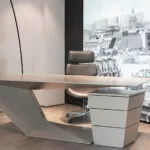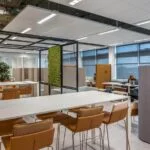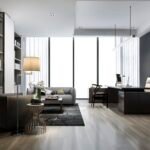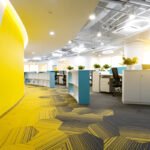Modern office spaces aren’t just places to work; they are reflections of brand identity, innovation, and culture. For real estate professionals, a thoughtfully designed office is more than aesthetic—it’s a strategic tool for attracting clients, fostering productivity, and cementing credibility. With the rise of workplace innovation, real estate offices are redefining how design can impact both employee satisfaction and business performance.
This blog dives into the top trends shaping real estate office spaces, exploring the creative integrations transforming operations. We’ll also look at case studies, tips for implementing these trends, and insights into where real estate office design is headed.
Why Office Interior Design Matters in Real Estate
The real estate industry has evolved beyond simply providing space—today, it’s about creating environments that inspire trust and connection. With offices acting as client-facing hubs, their interiors must reflect the confidence and professionalism expected of industry leaders.
But here’s the twist: modern office design is no longer just visual. Today’s design philosophies prioritize functionality, well-being, and adaptability—making them crucial for employee morale and client impressions.
From lease negotiations to showcasing properties, every in-person interaction often begins at the office. Whether you’re an agent, developer, or architect, leveraging innovative designs can help enhance marketability and efficiency.
Now, let’s explore the current trends shaping this pivotal workspace transformation.
Current Trends in Real Estate Office Interior Design

1. Flexible Workspaces
Gone are the days of rigid cubicles and fixed seating arrangements. Real estate offices are adopting flexible workstations where employees can collaborate or focus individually as needed.
- Adaptable Furniture: Include modular furniture that can be rearranged depending on the activity—whether it’s brainstorming sessions or client meetings. Think standing desks, movable partitions, or shared lounge areas.
- Activity-Based Zones: Design distinct zones for work categories, from quiet areas for focused research to conversation-friendly collaboration spaces.
This trend recognizes that real estate professionals need versatile, dynamic layouts that match their varied tasks on any given day.
2. Biophilic Design
Biophilic design—bringing nature into workspaces—is taking over office interiors to promote well-being. Studies show that exposure to natural elements like plants can reduce stress and improve focus, which is vital for fast-paced industries like real estate.
- Green Walls or Vertical Gardens: Real estate offices are increasingly adding plant installations or green walls to lobbies and shared spaces.
- Natural Light: Large window designs and glass walls ensure spaces are rich in sunlight, boosting moods and energy levels.
Clients entering biophilic offices often feel instantly at ease, while employees benefit from a rejuvenating environment that enhances creativity.
3. Technology Integration
Smart technologies are revolutionizing workspace designs to create seamless working experiences. For real estate offices, where digital tools like AR/VR property tours are routine, office tech must also make a statement.
- Interactive Displays: Install touchscreens in meeting rooms or common areas that showcase property portfolios, financial reports, or live feeds of project updates.
- Smart Office Solutions: Real-time scheduling for hot desks or meetings, as well as integrated lighting and HVAC systems that adapt to occupancy, are rising in popularity.
Not only does this tech improve operational efficiency, but it also impresses clients and future-proofs the workspace.
4. Sustainable and Eco-Friendly Elements
Sustainability isn’t just a trend; it’s a non-negotiable aspect of modern office design. Real estate offices are focusing on eco-conscious interiors for long-term resilience and brand differentiation.
- Recyclable Materials: Use reclaimed timber, recycled glass, or eco-friendly paint options to design spaces while reducing waste.
- Energy Efficiency: LED lighting, automated energy systems, and climate-responsive architecture are dominating design blueprints.
By prioritizing sustainability, real estate companies can position themselves as environmentally responsible, attracting clients who share a commitment to green initiatives.
Also Read: Inspiring Office Cabin Designs
What’s Next? The Future of Real Estate Office Design
1. AI-Driven Design: Artificial intelligence might soon assist in designing workplaces where desk allocations, layouts, and workflows are optimized for maximum productivity.
2. Wellness and Mindfulness Spaces: Beyond biophilic design, offices may create wellness zones that include meditation pods, yoga rooms, or soundproof recharge areas.
3. Immersive Technology: Expect virtual reality meeting rooms and smart sensory environments that respond to motion, light, and sound—all working together to boost collaboration and energy.
4. Hyperlocal Design: Workspaces may increasingly reflect their geographical aesthetics, incorporating hyperlocal artisan works and culture into interiors to offer authenticity.
How to Implement Design Trends in Real Estate Office Design
1. Identify Core Needs: What does your real estate office lack right now? Evaluate existing inefficiencies and opportunities for improvement.
2. Start Small: If a full revamp isn’t possible, prioritize one area—upgrade your client lounge or create a flexible workspace zone.
3. Consult Experts: Collaborate with professional interior designers who understand the real estate sector’s unique demands. They’ll bring both expertise and creativity to your redesign.
4. Allocate Budget Strategically: Focus your spend on timeless elements or tech that delivers the maximum ROI, such as energy-efficient systems or versatile furniture.
5. Iterate and Evolve: Design should never be static—review the space every few years and adapt it based on changing team sizes, client preferences, or new technologies.
Also Read: Creative Office Ceiling Design Ideas
Case Studies of Innovative Real Estate Office Redesigns

1. Robertson Realty’s Green HQ (Seattle, WA)
What they did:
- Redesigned their workspace with biophilic elements, including floor-to-ceiling glass windows, potted plants at every desk, and a sprawling indoor green wall.
Outcome:
- Employee satisfaction rose by 37%, and the office received praise for its inviting atmosphere. This redesign also attracted seven new high-profile clients within the first year.
2. UrbanSpaces Realty (New York, NY)
What they did:
- Integrated augmented reality (AR) zones where clients could explore virtual property tours right in the main office.
Outcome:
- AR features created buzz that appealed to tech-savvy clients, resulting in a 24% increase in property sales through office-based viewings.
Where Aesthetic Meets Performance 🚀
Real estate office design is no longer a back-burner concern—it’s a critical driver of productivity, client trust, and brand image. From flexible layouts infused with cutting-edge tech to sustainable features that reflect social responsibility, today’s trends reshape the way workspaces function.
Are you currently innovating within your workspace? Share your favorite office redesign ideas in the comments below! Need actionable advice tailored to your company? Connect directly with us for a deeper discussion.
FAQs
How long does it take to redesign a real estate office?
Redesign timelines can vary depending on the size and scope of the project. Small upgrades might take a few weeks, while large-scale overhauls can take several months.
Is incorporating technology in office design expensive?
It doesn’t have to be! Start with affordable tools like smart lighting or simple scheduling displays. Many tech solutions provide savings in the long term.
Why is biophilic design so popular in offices?
Biophilic design not only improves aesthetics but also boosts employee well-being and productivity. Natural elements help create calming and inspirational environments.
What is the most crucial trend in office design right now?
Sustainability is leading the way. From choosing eco-friendly materials to energy-saving systems, businesses are increasingly prioritizing green solutions in their design strategies.










Leave a comment